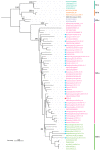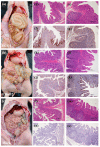The Characterization and Pathogenicity of a Recombinant Porcine Epidemic Diarrhea Virus Variant ECQ1
- PMID: 37515178
- PMCID: PMC10383920
- DOI: 10.3390/v15071492
The Characterization and Pathogenicity of a Recombinant Porcine Epidemic Diarrhea Virus Variant ECQ1
Abstract
Porcine epidemic diarrhea virus (PEDV), a re-emerging enteropathogenic coronavirus, has become the predominant causative agent of lethal diarrhea in piglets, resulting in huge economic losses in many countries. Furthermore, the rapid variability of this virus has increased the emergence of novel variants with different pathogenicities. In this study, 633 fecal samples collected from diarrheic piglets in China during 2017-2019 were analyzed, and 50.08% (317/633) of these samples were PEDV-positive. The full-length spike (S) genes of 36 samples were sequenced, and a genetic evolution analysis was performed. The results showed that thirty S genes belonged to the GII-a genotype and six S genes belonged to the GII-b genotype. From the PEDV-positive samples, one strain, designated ECQ1, was successfully isolated, and its full-length genome sequence was determined. Interestingly, ECQ1 is a recombinant PEDV between the GII-a (major parent) and GII-b (minor parent) strains, with recombination occurring in the S2 domain of the S gene. The pathogenicity of ECQ1 was assessed in 5-day-old piglets and compared with that of the strain EHuB2, a representative of GII-a PEDV. Although both PEDV strains induced similar fecal viral shedding in the infected piglets, ECQ1 exhibited lower pathogenicity than did EHuB2, as evidenced by reduced mortality and less severe pathological changes in the intestines. These data suggest that PEDV strain ECQ1 is a potential live virus vaccine candidate against porcine epidemic diarrhea.
Keywords: epidemiology; pathogenicity; porcine epidemic diarrhea virus; recombination; variant.
Conflict of interest statement
The authors declare no conflict of interest.
Figures






Similar articles
-
Biological Characteristics and Pathogenicity Analysis of a Low Virulence G2a Porcine Epidemic Diarrhea Virus.Microbiol Spectr. 2023 Jun 15;11(3):e0453522. doi: 10.1128/spectrum.04535-22. Epub 2023 May 18. Microbiol Spectr. 2023. PMID: 37199637 Free PMC article.
-
Infection, genetic and virulence characteristics of porcine epidemic diarrhea virus in northwest China.Infect Genet Evol. 2018 Aug;62:34-39. doi: 10.1016/j.meegid.2018.04.001. Epub 2018 Apr 4. Infect Genet Evol. 2018. PMID: 29625238
-
Deletion of a 197-Amino-Acid Region in the N-Terminal Domain of Spike Protein Attenuates Porcine Epidemic Diarrhea Virus in Piglets.J Virol. 2017 Jun 26;91(14):e00227-17. doi: 10.1128/JVI.00227-17. Print 2017 Jul 15. J Virol. 2017. PMID: 28490591 Free PMC article.
-
Evolution, antigenicity and pathogenicity of global porcine epidemic diarrhea virus strains.Virus Res. 2016 Dec 2;226:20-39. doi: 10.1016/j.virusres.2016.05.023. Epub 2016 Jun 8. Virus Res. 2016. PMID: 27288724 Free PMC article. Review.
-
Porcine Epidemic Diarrhea Virus: An Updated Overview of Virus Epidemiology, Virulence Variation Patterns and Virus-Host Interactions.Viruses. 2022 Nov 2;14(11):2434. doi: 10.3390/v14112434. Viruses. 2022. PMID: 36366532 Free PMC article. Review.
Cited by
-
Bioinformatics Goes Viral: I. Databases, Phylogenetics and Phylodynamics Tools for Boosting Virus Research.Viruses. 2024 Sep 6;16(9):1425. doi: 10.3390/v16091425. Viruses. 2024. PMID: 39339901 Free PMC article. Review.
-
Epidemiological investigation, isolation, and pathogenicity of porcine epidemic diarrhea virus subtype G2c in Sichuan province.Arch Virol. 2025 May 16;170(6):129. doi: 10.1007/s00705-025-06308-3. Arch Virol. 2025. PMID: 40377695
-
Current Evolutionary Dynamics of Porcine Epidemic Diarrhea Virus (PEDV) in the U.S. a Decade After Introduction.Viruses. 2025 Apr 30;17(5):654. doi: 10.3390/v17050654. Viruses. 2025. PMID: 40431666 Free PMC article.
-
A Genetically Engineered Bivalent Vaccine Coexpressing a Molecular Adjuvant against Classical Swine Fever and Porcine Epidemic Diarrhea.Int J Mol Sci. 2023 Jul 26;24(15):11954. doi: 10.3390/ijms241511954. Int J Mol Sci. 2023. PMID: 37569329 Free PMC article.
References
-
- Have P., Moving V., Svansson V., Uttenthal A., Bloch B. Coronavirus infection in mink (Mustela vison). Serological evidence of infection with a coronavirus related to transmissible gastroenteritis virus and porcine epidemic diarrhea virus. Vet. Microbiol. 1992;31:1–10. doi: 10.1016/0378-1135(92)90135-G. - DOI - PMC - PubMed
-
- Debouck P., Pensaert M. Experimental infection of pigs with a new porcine enteric coronavirus, CV 777. Am. J. Vet. Res. 1980;41:219–223. - PubMed
Publication types
MeSH terms
LinkOut - more resources
Full Text Sources

